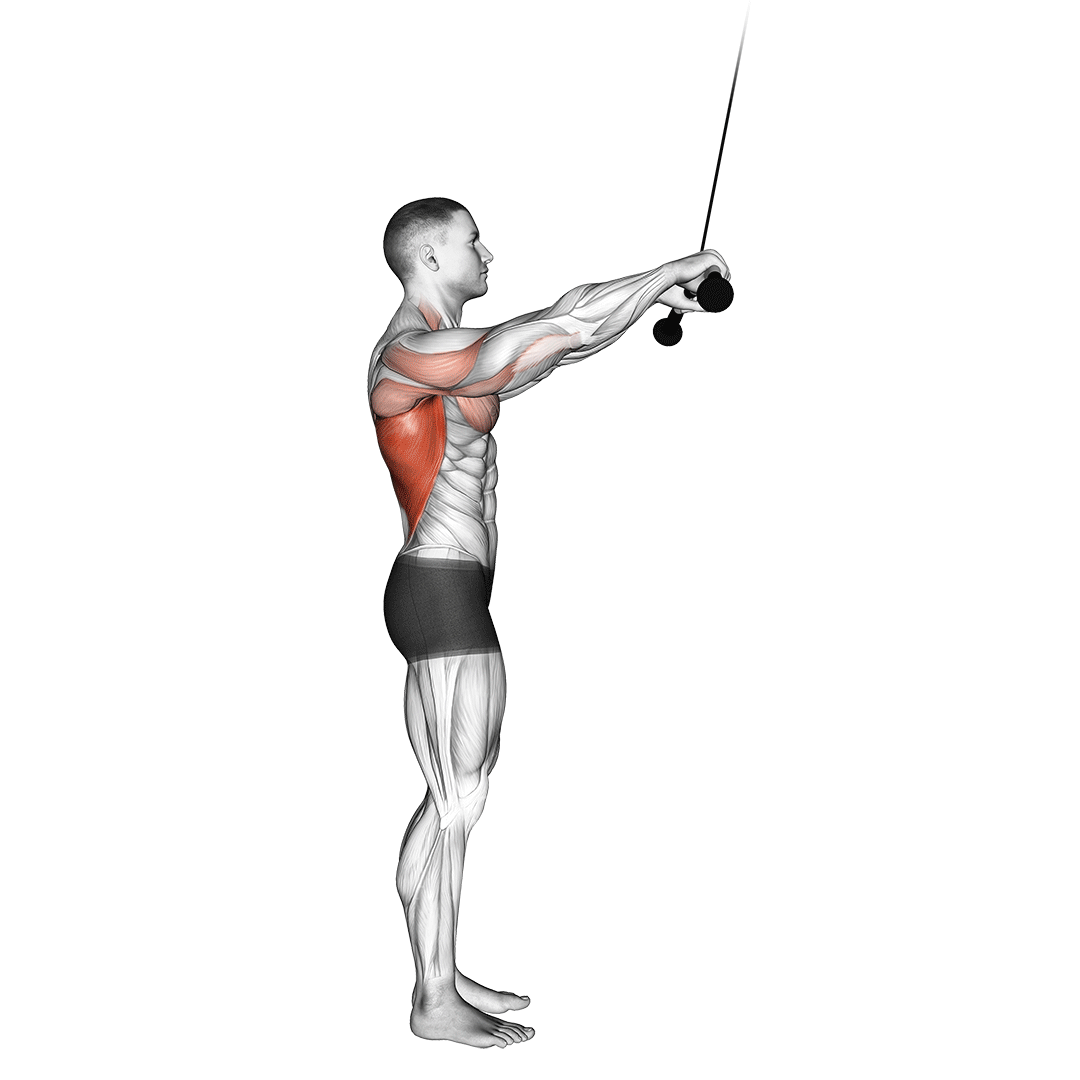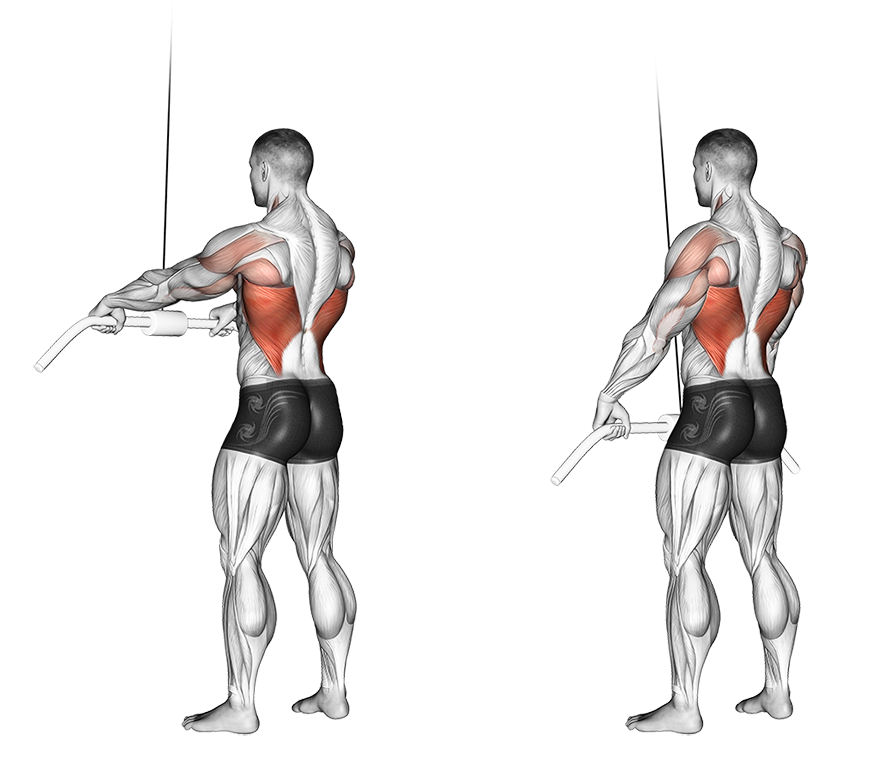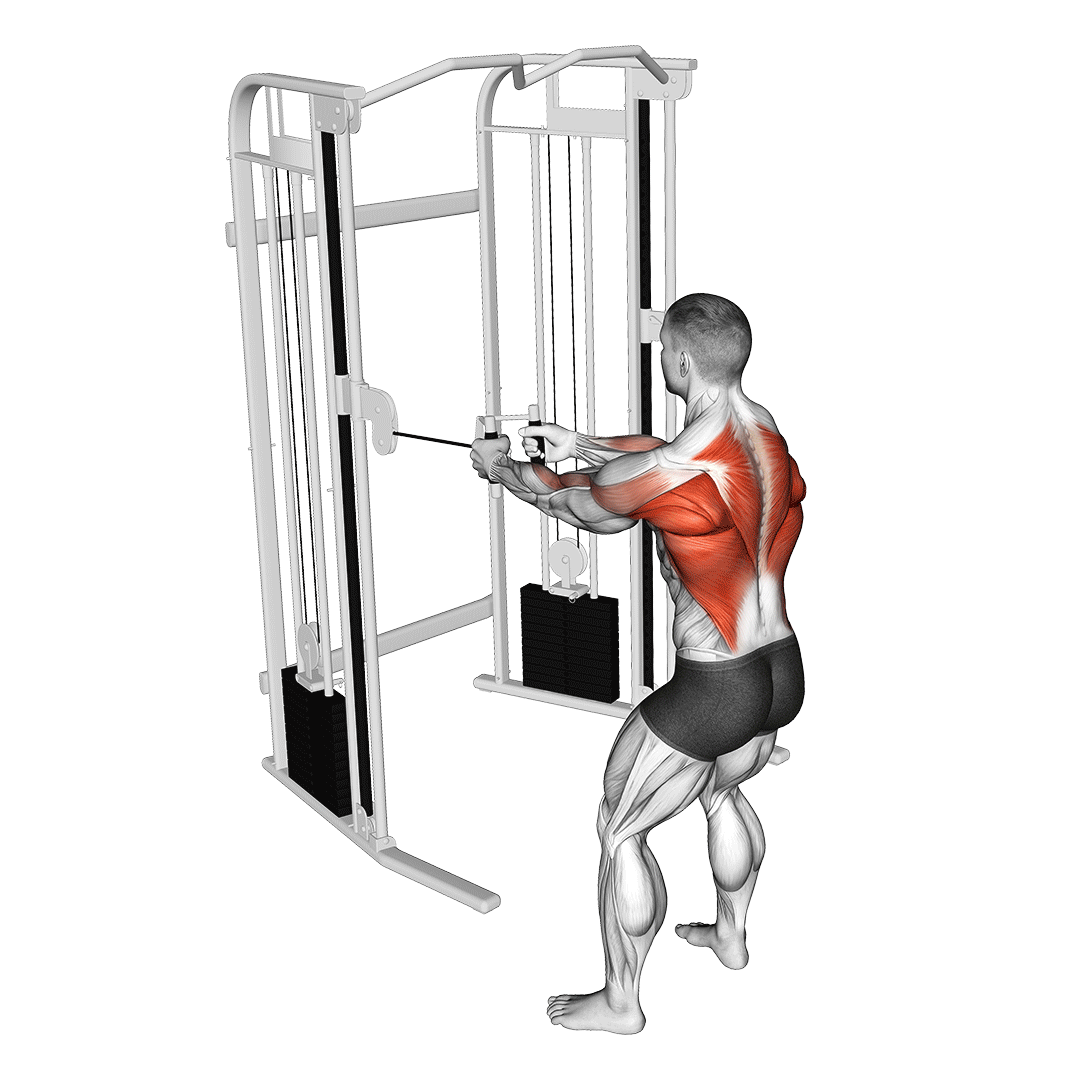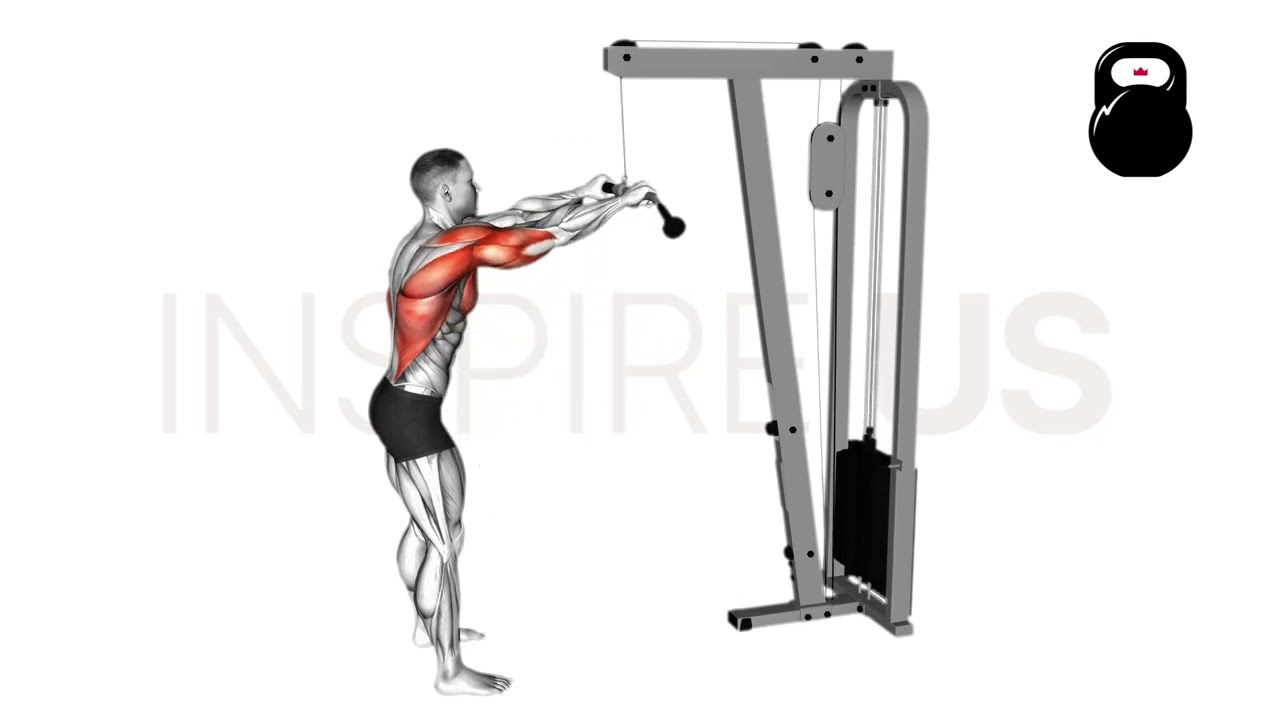Standing Straight Arm Lat Pulldown: Muscles Worked and More
Although the conventional lat pulldown is perfectly effective on its own, even greater development of the latissimus dorsi and nearby back muscles can be achieved by performing the exercise with straightened elbows in a standing position.
What is the Straight Arm Lat Pulldown?
The straight arm lat pulldown is a machine-based compound movement primarily targeting the muscles of the back and posterior shoulders.

As a variant of lat pulldown, the standing straight arm version allows for a significantly larger range of motion, more sweeping recruitment of the lats and reduced involvement of the elbow flexor muscles.
In training programming, standing straight arm lat pulldowns are used as a secondary compound movement to build both strength and mass in the largest muscles of the back.
They should be performed after heavy pulling movements like rows, pull-ups or deadlifts, but prior to more specific isolation exercises like shrugs or curls.
Lifters without access to a lat pulldown machine can alternatively make use of an adjustable cable machine and a straight bar attachment. The two are essentially identical, considering the standing position adopted.
How to Do a Standing Straight Arm Lat Pulldown
To perform a repetition of the standing straight arm lat pulldown, the lifter should set a cable pulley above their head, attaching a straight bar to the cable.
Gripping the handle double overhand with the hands slightly wider than shoulder-width apart, the lifter then steps far enough away that their arms are fully extended before their torso while their trunk remains otherwise vertical and upright.
Bending the knees slightly and hinging several inches forwards at the hips, the lifter then depresses their scapula and draws the handle downwards towards their quadriceps. The exercise should be felt in the latissimus dorsi and upper back, rather than the lower back, arms or chest.
Once the handle is sufficiently low enough for full latissimus dorsi contraction, the lifter slowly releases tension in their upper back and allows the resistance of the cable to draw their arms back upwards - elbows still straightened.
When back in the original starting position, the repetition is considered to be complete.
Sets and Reps Recommendation:
With such a widely reaching spread of recruitment, the straight arm pulldown can be loaded with a moderate or heavy amount of weight for greater muscular development.
3-4 sets of 8-12 repetitions should suffice for general training purposes.
What Muscles are Worked by the Standing Straight Arm Lat Pulldown?
The straight arm pulldown is a compound movement, meaning multiple muscle groups are recruited throughout its movement pattern.

These muscles are divided according to the type of contraction they primarily exhibit in the movement, with dynamic contraction marking a “mover” muscle and static contraction designating the muscle a “stabilizer”.
Mover muscles expend considerably more energy due to the non-static nature of their contraction, hence the fact that they receive the most benefit and are the central focus of the exercise.
Stabilizer muscles, on the other hand, solely play a supportive role and as such do not respond as much to straight arm pulldowns.
Mover Muscles
The primary mover muscle of the lat pulldown is - fittingly - the latissimus dorsi muscles that span across the entirety of the middle and lower back.
In addition to the lats are the various muscles of the upper back in a secondary capacity, with muscles like the rhomboids, trapezius, teres muscles and rhomboids either contracting weakly or only in a partial range of motion to support the lats.
Stabilizer Muscles
Apart from the aforementioned mover muscles, the posterior deltoid head, abdominal muscles and biceps brachii all act in a stabilizing capacity as well.
Common Straight Arm Lat Pulldown Mistakes to Avoid
To avoid injuries of the shoulders or poor muscular training response, avoid the following highly common mistakes.
Turning the Movement Into a Triceps Pushdown
Although it is indeed good technique to avoid absolute full extension of the elbows during a straight arm pulldown, utilizing too much of a bend can cause the triceps to become overly involved.
This essentially turns the exercise into a straight-bar triceps pushdown, greatly reducing the involvement of the back muscles and potentially injuring the elbows and triceps if the load is great enough.
Focus on deriving most of the movement’s force from the lats and upper back while minimizing how much elbow flexion is present.
Involving the Core or Lower Back
Much like allowing the triceps to become too involved, the straight arm lat pulldown should also be performed with as little forward tilt to the torso as possible.
Hinging too far forwards with the hip - or, worse, quite literally curling the torso forwards à la with cable crunches - can lead to serious injury of the lower back and its underlying section of spine.
Aim to only tilt the torso forwards by several degrees, utilizing hip hinging rather than bending at the waist or back as you do so.
Insufficient Range of Motion
Like with most other exercises, failing to complete a full range of motion will lead to alienation of certain muscle groups, overall poor muscular development and can even create issues like sticking points or instability.
With standing straight arm lat pulldowns, a full range of motion will begin with the arms raised straight forwards at approximately neck or chin level, featuring a wide and sweeping arc that ends with the elbows pointing behind the torso and the handle beneath the diaphragm at the least.
If struggling to complete a full range of motion, it is possible that the lifter either suffers from poor shoulder mobility or is otherwise attempting to perform the exercise with an excessive amount of weight.
Failing to Control Eccentric
To truly reap the most benefit from the exercise, controlling the eccentric (raising) section of the repetition is key.
As the resistance of the cable draws the handle back upwards, the latissimus dorsi should be contracted against said resistance, maintaining tension until the repetition is considered complete.
Failing to Point Elbows Behind Body
Lifters with difficulty properly engaging their lats may be failing to position their elbows and shoulders correctly during the exercise.
The easiest cue to follow for such a mistake is to simply angle the elbows so that they are pointing behind the body during the lower half of the range of motion. This creates the optimal position for the latissimus to contract despite a mild forward angle of the torso.
Variations and Alternatives of the Standing Straight Arm Lat Pulldown
If the straight arm lat pulldown irritates your shoulder - or if you just want to try a different angle of resistance - try the following substitute exercises out.
Rope Straight Arm Lat Pulldowns
A common complaint of using a straight bar with straight arm lat pulldowns is over-engagement of the triceps brachii and anterior deltoid heads. While this can be largely mitigated with proper technique, it is somewhat unavoidable if using a two-handed straight bar.

A more ideal solution would be to switch to using a two-handed rope attachment instead. Doing so will allow for a neutral grip, reducing triceps brachii involvement while simultaneously separating the two hands. The sole drawbacks to making such a swap is a less fixed movement pattern and a somewhat reduced loading capacity.
Standing Cable Machine Rows
For a more horizontal angle of resistance, simply adjusting the pulleys until it is parallel with the sternum will more than suffice.

Adjusting the angle of resistance in this direction essentially transforms the exercise into a cable row, requiring elbow flexion and shifting more emphasis towards the mid-back muscle groups.
Cable Crossover Lat Pulldowns
The cable crossover lat pulldown is a unique form of pulldown with an ever so slightly larger range of motion (for non-lat back muscles) and more laterally independent movement pattern.

The cable crossover variation of lat pulldown has the lifter kneeling before a dual tower cable machine and pulling the handles with the opposite hand so that the cables cross at the top of the movement.
Apart from featuring a larger ROM and forcing each side of the body to contract independently, the cable crossover pulldown is also excellent for lifters who find the straight arm variation irritating for their shoulders.
Frequently Asked Questions (FAQ)
Are Lat Pulldowns Standing or Seated?
Ideally, lat pulldowns should be performed seated. This largely eliminates the risk of “cheating” the repetition by bending the knees or curving the lower back.
Not to say that performing the movement standing can’t be beneficial, however. Performing standing lat pulldowns allows for a greater range of motion, so long as the arms remain straightened with minimal elbow flexion present.
Which Pulldown is Better for Lats?
The best variation of pulldown for targeting the lats will be one that reduces the involvement of other muscles as much as possible. This can be a minor alteration such as the wide grip lat pulldown, or something far more distinct like the kneeling straight arm lat pulldown.
Is a Straight Arm Lat Pulldown Better than a Wide Grip Lat Pulldown?
Both straight arm and wide grip lat pulldown serve much the same purpose, differing only by their angle of resistance and involvement of secondary mover muscles.
For absolute elimination of the elbow flexor muscles, the straight arm variation is superior. However, doing so will often contract the triceps and anterior deltoid heads.
Likewise, for no triceps brachii involvement and greater posterior deltoid emphasis, the wide grip variation is considered superior.
In terms of pure latissimus dorsi recruitment, the two are about equal, especially when torso angle is taken into account.
References
1. Andersen V, Fimland MS, Wiik E, Skoglund A, Saeterbakken AH. Effects of grip width on muscle strength and activation in the lat pull-down. J Strength Cond Res. 2014 Apr;28(4):1135-42. doi: 10.1097/JSC.0000000000000232. PMID: 24662157.
2. Snyder BJ, Leech JR. Voluntary increase in latissimus dorsi muscle activity during the lat pull-down following expert instruction. J Strength Cond Res. 2009 Nov;23(8):2204-9. doi: 10.1519/JSC.0b013e3181bb7213. PMID: 19826307.

